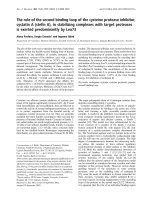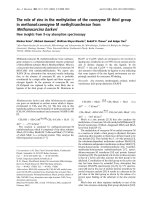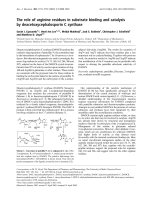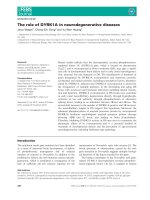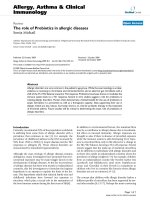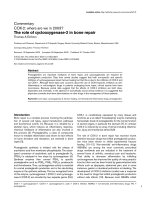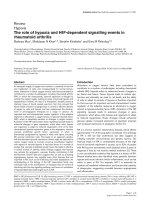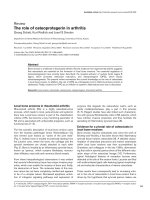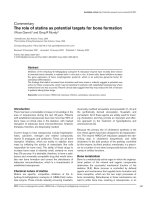Báo cáo y học: "The role of Probiotics in allergic diseases" pptx
Bạn đang xem bản rút gọn của tài liệu. Xem và tải ngay bản đầy đủ của tài liệu tại đây (564.36 KB, 7 trang )
BioMed Central
Page 1 of 7
(page number not for citation purposes)
Allergy, Asthma & Clinical
Immunology
Open Access
Review
The role of Probiotics in allergic diseases
Sonia Michail
Address: Department of Gastroenterology and Nutrition, Wright State University Boonshoft School of Medicine Dayton Children's Medical Center,
Dayton, Ohio 45404, USA
Email: Sonia Michail -
Abstract
Allergic disorders are very common in the pediatric age group. While the exact etiology is unclear,
evidence is mounting to incriminate environmental factors and an aberrant gut microbiota with a
shift of the Th1/Th2 balance towards a Th2 response. Probiotics have been shown to modulate the
immune system back to a Th1 response. Several in vitro studies suggest a role for probiotics in
treating allergic disorders. Human trials demonstrate a limited benefit for the use of probiotics in
atopic dermatitis in a preventive as well as a therapeutic capacity. Data supporting their use in
allergic rhinitis are less robust. Currently, there is no role for probiotic therapy in the treatment
of bronchial asthma. Future studies will be critical in determining the exact role of probiotics in
allergic disorders.
Introduction
Currently, an estimated 20% of the population worldwide
is suffering from some form of allergic disorder with a
prevalence that continues to rise [1]. For example, the
prevalence of childhood asthma in the USA increased by
50% from 1980 to 2000 [2]. Atopic diseases involve Th2
responses to allergens [3]. These clinical disorders are
characterized by immediate hypersensitivity.
Although the exact etiology of allergic diseases remains
ambiguous, many investigators have proposed that envi-
ronmental exposures may be major trigger factors in the
development of allergic diseases. As the rise in prevalence
of allergic diseases has been seen mostly in industrialized
countries, this led investigators to formulate the hygiene
hypothesis in an attempt to explain the basis of the dis-
ease. This hypothesis entails that reduced family size and
childhood infections have lowered our exposure to
microbes, which play a crucial role in the maturation of
the host immune system during the first years of life[4].
In addition to environmental factors, the intestinal flora
may be a contributor to allergic disease due to its substan-
tial effect on mucosal immunity. Allergic responses are
thought to arise if there is absence of microbial exposure
while the immune system is still developing [5,6]. Expo-
sure to microbial flora early in life allows for a change in
the Th1/Th2 balance, favoring a Th1 cell response. Several
reports suggest that the make-up of intestinal microflora
can be different in individuals with allergic disorders and
in those who reside in industrialized countries where the
prevalence of allergy is higher [7-9]. For example, children
from an industrialized country like Sweden harbor less
Lactobacilli and Bifidobacteria (and more Staphylococcus
aureus and Clostridia) in their bowels in comparison to
children who live in countries like Estonia where allergic
disorders are not as common [10-12].
The concept that children with allergic disorder harbor a
different profile of microflora has been supported by sev-
eral other studies [8,13-17]. Perhaps the most convincing
Published: 22 October 2009
Allergy, Asthma & Clinical Immunology 2009, 5:5 doi:10.1186/1710-1492-5-5
Received: 1 October 2009
Accepted: 22 October 2009
This article is available from: />© 2009 Michail; licensee BioMed Central Ltd.
This is an Open Access article distributed under the terms of the Creative Commons Attribution License ( />),
which permits unrestricted use, distribution, and reproduction in any medium, provided the original work is properly cited.
Allergy, Asthma & Clinical Immunology 2009, 5:5 />Page 2 of 7
(page number not for citation purposes)
of these is the KOALA study, which examined flora of 957
infants in the Netherlands [18]. The study revealed that C.
dificile colonization at one month of age was associated
with an increased likelihood of eczema, recurrent wheez-
ing, and atopic dermatitis. E. coli colonization was associ-
ated with eczema rather than recurrent wheezing or atopic
dermatitis. No association with bifidobacteria coloniza-
tion, B. fragilis or lactobacilli colonization was observed.
While this concept has been validated in several other
studies, there are a few reports that do not show a signifi-
cant difference in microflora composition. A recent study
comparing microflora composition of 324 European
infants showed no association between food sensitization
or atopic dermatitis and the intestinal bacteria [19]. In
general, however, most studies suggest that an association
exists.
Mechanisms of action of probiotics in allergic disorders
The United Nations Food and Agricultural Organization
and the World Health Organization define probiotics as
"live microorganisms, which, when administered in ade-
quate amounts, confer a health benefit to the host" [20].
Prebiotics are defined as non-digestible oligosaccharides,
such as fructo-oligosaccharides and trans-beta-galacto-oli-
gosaccharides, that selectively stimulate the growth of bifi-
dobacteria and lactobacilli, thus producing a prebiotic
effect. Synbiotics is a term referring to the use of both
prebiotics and probiotics simultaneously.
As described above, allergic disorders are associated with
a shift of the Th1/Th2 cytokine balance towards a Th2
response. This leads to activation of Th2 cytokines and the
release of interleukin-4 (IL-4), IL-5, and IL-13 as well as
IgE production [21].
Probiotics can potentially modulate the toll-like receptors
and the proteoglycan recognition proteins of enterocytes,
leading to activation of dendritic cells and a Th1 response.
The resulting stimulation of Th1 cytokines can suppress
Th2 responses [21]. Pediatric studies suggest that probi-
otic use in children with atopic conditions such as atopic
dermatitis results in enhancement of IFN-production and
decrease d IgE and antigen-induced TN F-, IL-5, and IL-10
secretion [22-24].
The role of probiotics in allergic disorders
The interest in probiotic therapeutic potential in allergic
disorders stemmed from the fact that they have been
shown to reduce inflammatory cytokines and improve
intestinal permeability in vitro. Such effects would be
desirable in treating allergic disorders. Therefore, several
studies have been designed to examine the efficacy of pro-
biotics in many allergic conditions, such as eczema, aller-
gic rhinitis, asthma and food allergies.
a) Role of probiotics in atopic dermatitis
Several human trials, as well as, numerous animal and in
vitro studies suggest a beneficial effect of probiotics in
allergic diseases. The therapeutic and preventive role of
probiotics in atopic dermatitis has been extensively stud-
ied.
1. Prevention of atopic dermatitis
The prevention of allergic diseases relies heavily on pre-
venting sensitization to an offending allergen. Enomoto
and colleagues investigated the association of consump-
tion of fermented dairy products and the development of
allergy and allergic sensitization in Japanese students as
reflected on serum levels of total IgE values, specific IgE to
house dust mite and Japanese cedar pollen. The report
demonstrated a significant reduction in allergy develop-
ment among the students consuming fermented milk in
comparison with students who did not consume fer-
mented products[25].
The effect of probiotics on preventing atopic dermatitis
has been demonstrated in randomized studies from Fin-
land where Lactobacillus GG or placebo was given to preg-
nant mothers with a strong family history of eczema,
allergic rhinitis or asthma, and to their infants for the first
six months after delivery. The frequency of developing
atopic dermatitis in the offspring was significantly
reduced by 2, 4, and 7 years [26-28], by 50%, 44%, and
36% respectively.
Similar studies have yielded comparable results. The use
of the probiotic E-coli in the early postnatal period
decreased the incidence of serum specific IgE allergies at
10 and 20 years of age in a long-term prospective study
[29,30]. Other studies could only relate probiotic benefits
to a certain subset of dermatitis patients. The incidence of
IgE-associated dermatitis, rather than other types of atopic
dermatitis, was decreased after the oral consumption of
probiotics, namely L. reuteri or a mixture of four probiotic
bacteria and prebiotics [31,32]. However, Taylor et al
could not confirm such effects in a randomized placebo-
controlled double-blind study. L. acidophilus did not
decrease the risk of developing allergy in a large number
of infants[33,34]. There were two major differences
between Taylor
D
s study and the others. The type of probi-
otic product was different as well as the timing of the
introduction of the probiotic, Taylor et al administered
the probiotic supplement postnatally, while other studies
administered probiotics before and after birth. Prenatal
supplementation may prove to be crucial for the preven-
tive benefit of probiotics in this disorder.
Prebiotic oligosaccharides have also been shown to
reduce the incidence of atopic dermatitis when given to
infants at risk for atopy during the first six months of
Allergy, Asthma & Clinical Immunology 2009, 5:5 />Page 3 of 7
(page number not for citation purposes)
age[35]. No comparisons made to probiotics and have
not been used prenatally.
A recent Cochrane review meta-analysis found a signifi-
cant reduction in the likelihood of developing infant
eczema with the use of probiotics. The meta-analysis
described five studies enrolling 1477 infants. However,
the authors found significant heterogeneity and with fur-
ther focused on children with dermatitis that have posi-
tive skin prick test or specific IgE sensitization, there were
no significant benefits noted with probiotics. The authors
concluded that there was no current evidence to support
the administration of probiotics to prevent eczema and
recommended further studies to determine reproducibil-
ity[36].
In general, the role for probiotics in the prevention of
atopic dermatitis (table 1) awaits future studies.
2. Treatment of atopic dermatitis
Once allergic diseases develop, one goal of therapy is to
control the patient's clinical symptoms. Probiotics may
help to decrease the severity of atopic dermatitis and food
allergy. Most clinical studies have targeted pediatric
patients (table 2).
In 1997, the first published study in this area [37] exam-
ined the effect of Lactobacillus GG in mild atopic eczema in
a modest number of infants. After four weeks, SCORAD
scores dropped from 26 to 15, while the control group
only changed from 21 to 19. However, one month after
the probiotic was discontinued, both groups had compa-
rable SCORADs. Therefore, in this particular study, the
effect of the probiotic was short lived.
The same group of investigators subsequently published
two additional studies. One study, published in 2000[38],
compared Lactobacillus GG, or Bifidobacterium lactis Bb-1 2
to placebo. After two months SCORAD scores decreased
from a baseline of 16 to 1, 0, and 13.4 respectively. How-
ever, after 6 months, the median SCORAD was zero (0-
6.6) in all groups, suggesting that the probiotic effect is
limited to rapid initiation of improvement in mild dis-
ease. The other study underscored the importance of via-
bility [39]. While live probiotic administration resulted in
statistically significant improvement of scores, the use of
heat-inactivated Lactobacillus GG was associated with
adverse gastrointestinal symptoms and further study
enrollment was thus halted.
Another study by Kirjavainen et al suggested that Bifido-
bacterium lactis Bb12 modifies gut microflora to alleviate
early onset atopic eczema[7]. A randomized, but not pla-
cebo-controlled study suggested that synbiotics and preb-
iotics significantly improve atopic dermatitis in older
children [40].
Table 1: Prevention of sensitization and allergic diseases
Author Year Study type Probiotic type Results
Abrahamsson 2007 R, C, DB L. reuteri Decreased IgE-associated eczema
Kalliomäki 2007 R, PC, DB LGG Decreased atopic dermatitis
Kukkonen 2007 R, PC, DB LGG, L. rhamnosus LC705, B. breve Bb99, P.
freudenreichii ssp shermanii JS
Lower IgE-associated diseases and eczema
Taylor 2007 R, PC, DB L. acidophilus LAVRI- Al No change in atopic dermatitis rates or
SCORAD
Taylor 2007 R, PC, DB L. acidophilus LAVRI- Al No change in atopic dermatitis
Lodinova- Zadnikova 2004 C E. coii Decreased long-term incidence of allergy
Kalliomäki 2003 R, PC, DB LGG Decreased atopic dermatitis
Lodinova- Zadnikova 2003 C E. coii Decreased allergy development
Kalliomäki 2001 R, PC, DB LGG Decreased atopic dermatatis
Rautava 2001 R, PC, DB LGG Decreased atopic dermatitis
R = randomized, C = controlled, PC = placebo-controlled, DB = double-blinded, LGG = Lactobacillus GG, SCORAD = severity scoring of atopic
dermatitis index
Allergy, Asthma & Clinical Immunology 2009, 5:5 />Page 4 of 7
(page number not for citation purposes)
The largest study (n = 230) to date, compared the effects
of Lactobacillus GG, a probiotic mix, or placebo[41]. There
was no difference between the groups after 4 weeks of
therapy, or4 weeks after study supplement was discontin-
ued. However, infants receiving Lactobacillus GG who had
specific IgE sensitization had a greater reduction in SCO-
RAD when compared to the placebo group (-26.1 versus -
19.8, p = 0.036). Furthermore, a reduction of TNF-alpha
and an increase in fecal IgA levels were noted [42]. Two
other studies demonstrated comparable results. A study
Table 2: Probiotics in treatment of allergies
Author Year Study type Probiotic type Results
Giovannini 2007 R, PC, DB L. casei DN-114001 Longertime free from asthmaIrhinitis episodes Less number of episodes
of rhinitis episodes
Tamura 2007 R, PC, DB L. casei strain shirota No change in allergic rhinitis
Xiao 2007 R, PC, DB B. Ion gum BBS36 Ameliorate Japanese cedar pollinosis
Brouwer 2006 R, PC, DB L. rhamnosus I LGG Lower SCORAD (no different from placebo)
Fälster-Holst 2006 R, PC, DB L. rhamnosus GG Lower SCORAD (no different from placebo)
Passeron 2006 R, PC, DB L. rhamonosus Lcr35 and prebiotic Decreased SCORAD
Sistek 2006 R, PC, DB L. rhamnosus, B. lactis Decreased SCORAD
Xiao 2006 R, PC, DB B. Iongum BBS36 Ameliorate Japanese cedar pollinosis
Xiao 2006 R, PC, DB B. Iongum BBS36 Ameliorate Japanese cedar pollinosis
Ciprandi 2005 C Bacillus clausii spores Decreased nasal symptoms
Ishida 2005 R, PC, DB L. acidophil us L-92 Decreased nasal and ocular symptoms
Peng 2005 R, PC, DB L. plantar um 33 Decreased perennial allergic rhinitis
Viljanen 2005 R, PC, DB LGG or MIX Decreased SCORAD
Weston 2005 R, PC, DB L. ferment um Decreased SCORAD
Rosenfeldt 2004 R, PC, DB L. rhamnos us and L. re uteri Decreased frequency of gastrointestinal symptoms and
lactulose:mannitaol ratio
Wang 2004 R, PC, DB L. paracasei Decreased frequency and level of bother of allergic rhinitis
Hattori 2003 C B. breve M-16V Ameliorate cutaneous and allergic symptoms
Kirjavainen 2003 R, PC, DB LGG Decreased SCORAD
Rosenfeldt 2003 R, PC, DB L. rhamnos us and L. re uteri Decreased SCORAD
Helin 2002 R, PC, DB LGG No effect on birch pollen allergy
Isolauri 2000 R, PC, DB B. lactis (Bb-12) or LGG Decreased SCORAD
Majamaa 1997 R, PC, DB LGG Decreased SCORAD
Wheeler 1997 R, PC, DB L. acidophil us Increased IFN-and less eosinophilia
R = randomized, C = controlled, PC = placebo-controlled, DB = double-blinded, LGG = Lactobacillus GG, SCORAD = severity scoring of atopic
dermatitis index
Allergy, Asthma & Clinical Immunology 2009, 5:5 />Page 5 of 7
(page number not for citation purposes)
by Rosenfeldt et al. from Denmark used lyophilized Lacto-
bacillus rhamnosus 19070-2 and Lactobacillus reuteri DSM
122460) in older children (average age 5.2 years), and sta-
tistically significant improvement in SCORAD was only
seen in a subset of children with positive skin prick test
and elevated IgE levels [43]. Another study by Sistek et al.
showed efficacy of the probiotic Lactobacillus rhamnosus
and Bifidobacteria lactis in food-sensitized children[44].
Those three studies taken together reveal that probiotics
were not effective for all children with atopic dermatitis
but rather in the subset of IgE sensitized children.
However, a study from the Netherlands by Brouwer et
al.[45] and another study from Germany by Folster-Holst
et al.[46] showed no effect of Lactobacillus rhamnosus or
Lactobacillus GG in infants with atopic dermatitis regard-
less of their IgE sensitization status.
In 2005, Weston et al.[47] from Australia published their
experience with using Lactobacillus fermentum VRI-003
PCC for 8 weeks in 53 infants with atopic dermatitis. After
16 weeks the probiotic group had significant reduction of
SCORAD scores (p = 0.03) while the placebo group did
not (p = 0.83). However, while the change in SCORAD
scores from baseline in the probiotic group was signifi-
cant, the difference between the probiotic and placebo
group did not quite reach statistical significance (p = 0.06)
by the 16
th
week.
As pointed out by Passeron and Lacour, in their letter to
the editor[48], children receiving placebo treatment in
many of these studies significantly improved within a
much shorter than expected time. Cellulose and maltose
dextran were used as placebo, which could have a prebi-
otic effect thus explaining the improvement seen in the
placebo group. To further examine this effect, the same
investigators compared the effects of prebiotics and probi-
otics (synbiotics) versus prebiotics alone and concluded
that both groups had a significant reduction in the SCO-
RAD scores after 3 months[40].
The most recent randomized trial was designed to investi-
gate the therapeutic benefit of Lactobacillus rhamnosus
GG (LGG) in infants with atopic dermatitis. Infants 3-12
months of age with mild-to-moderate atopic dermatitis
were randomized to receive LGG or placebo as a food sup-
plement for 12 weeks. Fifty-four infants received LGG and
48 infants received placebo. Symptoms improved over-
time after 4, 8, and 12 weeks, without any group being sta-
tistically different [49].
A recent meta-analysis suggested that probiotics may ben-
efit children and infants with the disorder [50]. The meta-
analysis identified ten randomized, controlled trials. A
significant overall benefit was demonstrated after the use
of probiotics, resulting in a reduction of the dermatitis
scores (SCORAD) compared to placebo. Lactobacillus GG
appeared to be more effective than other probiotic prepa-
rations and children with more severe disease were more
likely to benefit from the use of probiotics. Another recent
meta-analysis did not show a therapeutic difference
among children receiving probiotics [51]. However, this
analysis excluded six of the ten studies published, making
the validity of the report questionable.
Other studies have examined the effect of probiotic con-
sumption on sensitization to several allergens (e.g. pea-
nut, hen's egg, soy, wheat, milk, cat, dog), as determined
by specific IgE production or skin prick test reaction
(SPT). The authors could not find a difference before and
after the treatment[22,26,45].
Taken together, some of these studies show a slight bene-
fit over placebo for the treatment of atopic dermatitis.
However, several of the studies show no benefit.
b) The role of probiotics in Asthma
A small number of studies exist that try to address the effi-
cacy of probiotic supplementation in the treatment or pre-
vention of asthma. Such studies have heavily focused on
the treatment rather than prevention of asthma. Perhaps
the largest and the most recent trial was conducted by Gio-
vannini and colleagues using fermented milk containing
Lactobacillus casei and studying its effect on the number of
episodes of asthma and allergic rhinitis[52]. One hundred
and eighty seven children, between two and five years of
age, were included in the study. At the end of the twelve-
month trial period the investigators found no statistical
difference between intervention and control groups of
asthmatic children. However, the number of rhinitis epi-
sodes was lower in the probiotic group leading the
authors to conclude that Lactobacillus casei may benefit
children with allergic rhinitis but not asthmatic children.
One randomized placebo-controlled crossover study
examined the effect of yogurt containing S. thermophilus
and Lactobacillus bulgaricus when given with or without
Lactobacillus acidophilus to adolescents and adults with
asthma who were sensitized to inhalant allergens. There
was no difference in clinical parameters of asthma or lab-
oratory markers of inflammation[53]. One concern with
this experimental design arises from the fact that the pla-
cebo group received yogurt mixed with bacteria that have
probiotic properties. At any rate, neither the active group
nor placebo had any improvement in lung function.
The efficacy of probiotics in asthma as a preventive meas-
ure has not been evaluated and may be worthwhile stud-
ying. However, to date there is no evidence to justify the
use of probiotics for treatment or prevention of asthma.
Allergy, Asthma & Clinical Immunology 2009, 5:5 />Page 6 of 7
(page number not for citation purposes)
c) The role of probiotics in Allergic Rhinitis
Reports on the efficacy of probiotics in treating allergic
rhinitis are conflicting. Some studies suggest efficacy such
as the study by Wang and colleagues, where Lactobacillus
paracasei-33 was given for 30 days to 80 children with per-
ennial rhinoconjunctivitis. The quality of life question-
naire scores significantly improved relative to
placebo[54]. A Japanese study demonstrated that intake
of Bifidobacterium lon gum BB536 as a yogurt supplement
is effective in relieving symptoms of Japanese cedar polli-
nosis[55,56]. Furthermore, a Finnish study suggested that
fermented milk prepared with Lactobacillus gasseri
TMC0356 could alter serum IgE concentration through a
Th1 immune response in subjects with perennial allergic
rhinitis[57]. Others reported that the ingestion of B.
longum reduced ocular and nasal symptoms as well as
need for medication, again in Japanese cedar pollinosis
[55,56,58,59]. With regard to house dust mite allergy, the
use of probiotics resulted in a reduction of symptoms in
children and adults with allergic rhinitis [60,61]. In a
recent study by Giovannini [52], L. casei DN-1 14 001
reduced the number of rhinitis episodes in sixty-four pre-
school children with allergic rhinitis. Other studies did
not show benefit, for example, patients who were allergic
to birch pollen and apple food that were treated with L.
rhamnosus GG during the birch-pollen season, had no
reduction of symptom score, nor of sensitization to birch
pollen and apple after Lactobacillus rhamnosus supplemen-
tation [62] and L. casei strain Shirota did not reduce aller-
gic symptoms of Japanese cedar pollen allergy [63].
Summary
Probiotics may have a potential role in the prevention and
treatment of atopic dermatitis, but studies to date have
not been conclusive. Parents should be aware that une-
quivocal benefit remains to be found. However, the effect
can be modest and may depend on the target population.
The data addressing the effect of probiotics in allergic
rhinitis is even less robust.
Currently, there is no role for probiotic therapy in the
treatment of asthma. Future studies will be important to
refine the current knowledge base for potential use of pro-
biotics in allergy.
Competing interests
The author declares that they have no competing interests.
References
1. Warner JO, et al.: Allergy practice worldwide. a report by the
World Allergy Organization Specialty and Training Council.
Int Arch Allergy Immunol 2006, 139(2):166-74.
2. Lovasi GS, et al.: Children living in areas with more street trees
have lower prevalence of asthma. J Epidemiol Community Health
2008, 62(7):647-9.
3. Romagnani S: Thiand Th2 in human diseases. Clin Immunol Immu-
nopathol 1996, 80(3 Pt 1):225-35.
4. Flohr C, Pascoe D, Williams HC: Atopic dermatitis and the
'hygiene hypothesis'. too clean to be true? Br J Dermatol 2005,
152(2):202-16.
5. Ouwehand AC: Antiallergic effects of probiotics. J Nutr 2007,
137(3 Suppl 2):794S-7S.
6. Ogden NS, Bielory L: Probiotics. a complementary approach in
the treatment and prevention of pediatric atopic disease.
Curr Opin Allergy Clin Immunol 2005, 5(2):179-84.
7. Kirjavainen PV, et al.: Aberrant composition of gut microbiota
of allergic infants. a target of bifidobacterial therapy at wean-
ing? Gut 2002, 51(1):51-5.
8. Kirjavainen PV, et al.: Characterizing the composition of intes-
tinal microflora as a prospective treatment target in infant
allergic disease. FEMS Immunol Med Microbiol 2001, 32(1):1-7.
9. Bjorksten B: The gastrointestinal flora and the skin Is there a
link? Pediatr Allergy Immunol 2001, 12(Suppi 14):51-5.
10. Sepp E, et al.: Intestinal microbiota and immunoglobulin E
responses in 5-year-old Estonian children. Clin Exp Allergy 2005,
35(9):1141-6.
11. Voor T, et al.
: Atopic sensitization and atopic dermatitis in
Estonian and Swedish infants. Clin Exp Allergy 2005, 35(2):153-9.
12. Bjorksten B, et al.: Allergy development and the intestinal
microflora during the first year of life. J Allergy Clin Immunol
2005, 108(4):16-20.
13. Watanabe S, et al.: Differences infecalmicroflora between
patients with atopic dermatitis and healthy control subjects.
J Allergy Clin Immunol 2005, 111(3):587-91.
14. Kirjavainen PV, Gibson GR: Healthy gut microflora and allergy.
factors influencing development of the microbiota. Ann Med
1999, 31(4):288-92.
15. Kalliomaki M, Isolauri E: Role of intestinal flora in the develop-
ment of allergy. Curr Opin Allergy Clin Immunol 2003, 3(1):15-20.
16. He F, et al.: Comparison of mucosal adhesion and species iden-
tification of bifidobacteria isolated from healthy and allergic
infants. FEMS Immunol Med Microbiol 2001, 30(1):43-7.
17. Ouwehand A, Isolauri E, Salminen S: The role of the intestinal
microflora for the development of the immune system in
early childhood. Eur J Nutr 2002, 41(Suppi 1):I32-7.
18. Penders J, et al.: Molecular finger printing of the intestinal
microbiota of infants in whom atopic eczema was or was not
developing. Clin Exp Allergy 2006, 36(12):1602-8.
19. Adlerberth I, et al.: Gut microbiota and development of atopic
eczema in 3 European birth cohorts. J Allergy Clin Immunol 2007,
120(2):343-50.
20. (WHO), FaAOFotUNaWHO: Guidelines for the Evaluation of
Probiotics in Food. Report of a Joint FAO/WHO Working
Group on Drafting Guidelines for the Evaluation of Probiot-
ics in Food.
. Accessed on December 7, 2006
21. Winkler P, et al.: Molecular and cellular basis of microflora-
host interactions. J Nutr 2007, 137(3 Suppl 2):756S-72S.
22. Flinterman AE, et al.: Probiotics have a different immunomodu-
latory potential in vitro versus ex vivo upon oral administra-
tion in children with food allergy. Int Arch Allergy Immunol 2007,
143(3):237-44.
23. Prescott SL, et al.: Clinical effects of probiotics are associated
with increased interferon-gamma responses in very young
children with atopic dermatitis. Clin Exp Allergy 2005,
35(12):1557-64.
24. Taylor AL, et al.: Effects of probiotic supplementation for the
first 6 months of life on allergen-and vaccine-specific
immune responses. Clin Exp Allergy 2006, 36(10):1227-35.
25. Enomoto T, Shimizu K, Shimazu S: [Suppression of allergy devel-
opment by habitual intake offermented milkfoods, evidence
from an epidemiological study]. Arerugi 2006, 55(11):1394-9.
26. Kalliomaki M, et al.: Probiotics in primary prevention of atopic
disease. a randomised placebo-controlled trial. Lancet 2001,
357(9262):1076-9.
27. Kalliomaki M, et al.: Probiotics and prevention of atopic disease.
4-yearfollow-up of a randomised placebo-controlled trial.
Lancet 2003, 361(9372):1869-71.
28. Kalliomaki M, et al.: Probiotics during the first 7 years of life: a
cumulative risk reduction of eczema in a randomized, pla-
cebo-controlled trial. J Allergy Clin Immunol 2007, 119(4):1019-21.
29. Lodinova-Zadnikova R, et al.: [Influence of oral colonization with
probiotic E. coli strain after birth on frequency of recurrent
infections, allergy and development of some immunologic
Publish with BioMed Central and every
scientist can read your work free of charge
"BioMed Central will be the most significant development for
disseminating the results of biomedical research in our lifetime."
Sir Paul Nurse, Cancer Research UK
Your research papers will be:
available free of charge to the entire biomedical community
peer reviewed and published immediately upon acceptance
cited in PubMed and archived on PubMed Central
yours — you keep the copyright
Submit your manuscript here:
/>BioMedcentral
Allergy, Asthma & Clinical Immunology 2009, 5:5 />Page 7 of 7
(page number not for citation purposes)
parameters. Long-term studies]. Ceska Gynekol 2004, 69(Suppi
1):91-7.
30. Lodinova-Zadnikova R, Cukrowska B, Tlaskalova-Hogenova H: Oral
administration of probiotic Escherichia coli after birth
reduces frequency of allergies and repeated infections later
in life (after 10 and 20 years). Int Arch Allergy Immunol 2003,
131(3):209-11.
31. Abrahamsson TR, et al.: Probiotics in prevention of IgE-associ-
ated eczema. a double-blind, randomized, placebo-control-
led trial. J Allergy Clin Immunol 2007, 119(5):1174-80.
32. Kukkonen K, et al.: Probiotics and prebiotic galacto-oligosac-
charides in the prevention of allergic diseases. a randomized,
double-blind, placebo-controlled trial. J Allergy Clin Immunol
2007, 119(1):192-8.
33. Taylor AL, et al.: FOXP3 mRNA expression at 6 months of age
is higher in infants who develop atopic dermatitis, but is not
affected by giving probiotics from birth. Pediatr Allergy Immunol
2007, 18(1):10-9.
34. Taylor AL, Dunstan JA, Prescott SL: Probiotic supplementation
for the first 6 months of life fails to reduce the risk of atopic
dermatitis and increases the risk of allergen sensitization in
high-risk children. a randomized controlled trial. J Allergy Clin
Immunol 2007, 119(1):184-91.
35. Moro G, et al.: A mixture of prebiotic oligosaccharides reduces
the incidence of atopic dermatitis during the first six months
of age. Arch Dis Child 2006, 91(10):814-9.
36. Osborn DA, Sinn JK: Probiotics in infants for prevention of
allergic disease and food hypersensitivity. Cochrane Database
Syst Rev 2007:CD006475.
37. Majamaa H, Isolauri E: Probiotics: a novel approach in the man-
agement of food allergy. J Allergy Clin Immunol 1997,
99(2):179-85.
38. Isolauri E, et al.
: Probiotics in the management of atopic
eczema. Clin Exp Allergy 2000, 30(11):1604-10.
39. Kirjavainen PV, Salminen SJ, Isolauri E: Probiotic bacteria in the
management of atopic disease. underscoring the impor-
tance of viability. J Pediatr Gastroenterol Nutr 2003, 36(2):223-7.
40. Passeron T, et al.: Prebiotics and synbiotics. two promising
approaches for the treatment of atopic dermatitis in chil-
dren above 2 years. Allergy 2006, 61(4):431-7.
41. Viljanen M, et al.: Probiotics in the treatment of atopic eczema/
dermatitis syndrome in infants. a double-blind placebo-con-
trolled trial. Allergy 2005, 60(4):494-500.
42. Viljanen M, et al.: Probiotic effects onfaecal inflammatory
markers and onfaecal IgA in food allergic atopic eczema/der-
matitis syndrome infants. Pediatr Allergy Immunol 2005,
16(1):65-71.
43. Rosenfeldt V, et al.: Effect of probiotic Lactobacillus strains in
children with atopic dermatitis. J Allergy Clin Immunol 2003,
111(2):389-95.
44. Sistek D, et al.: Is the effect of probiotics on atopic dermatitis
confined to food sensitized children? Clin Exp Allergy 2006,
36(5):629-33.
45. Brouwer ML, et al.: No effects of probiotics on atopic dermati-
tis in infancy. a randomized placebo-controlled trial. Clin Exp
Allergy 2006, 36(7):899-906.
46. Folster-Holst R, et al.: Prospective, randomized controlled trial
on Lactobacillus rhamnosus in infants with moderate to
severe atopic dermatitis. Br J Dermatol 2006, 155(6):
1256-61.
47. Weston S, et al.: Effects of probiotics on atopic dermatitis. a
randomised controlled trial. Arch Dis Child 2005, 90(9):892-7.
48. Passeron T, Lacour J: Effects of Probiotics on Atopic Dermati-
tis. Arch Dis Child 2005, 20(4):171-176.
49. Gruber C, et al.: Randomized, placebo-controlled trial of
Lactobacillus rhamnosus GG as treatment of atopic derma-
titis in infancy. Allergy 2007, 62(11):1270-6.
50. Michail S, Onady G, Stolfi A, Johnson T: Efficacy of probiotics in
treatment ofpediatric atopic dermatitis a meta-analysis of
randomized, controlled trials. 2008, 101(5):508-16.
51. Lee J, Seto D, Bielory L: Meta-analysis of clinical trials of probi-
otics for prevention and treatment of pediatric atopic der-
matitis. J Allergy Clin Immunol 2008, 121(1):116-121.
52. Giovannini M, et al.: A randomized prospective double blind
controlled trial on effects of longterm consumption offer-
mented milk containing Lactobacillus casei in pre-school
children with allergic asthma and/or rhinitis. Pediatr Res 2007,
62(2):215-20.
53. Wheeler JG, et al.: Immune and clinical impact of Lactobacillus
acidophilus on asthma. Ann Allergy Asthma Immunol 1997,
79(3):229-33.
54. Wang MF, et al.: Treatment of perennial allergic rhinitis with
lactic acid bacteria. Pediatr Allergy Immunol 2004, 15(2):152-8.
55. Xiao JZ, et al.: Probiotics in the treatment of Japanese cedar
pollinosis: a double-blind placebo-controlled trial. Clin Exp
Allergy 2006, 36(11):1425-35.
56. Xiao JZ, et al.:
Effect of probiotic Bifidobacterium longum
BB536 [corrected] in relieving clinical symptoms and modu-
lating plasma cytokine levels of Japanese cedar pollinosis
during the pollen season. A randomized double-blind, pla-
cebo-controlled trial. J Investig Allergol Clin Immunol 2006,
16(2):86-93.
57. Morita H, et al.: Preliminary human study for possible altera-
tion of serum immunoglobulin E production in perennial
allergic rhinitis with fermented milk prepared with Lactoba-
cillus gasseri TMCO356. Microbiol Immunol 2006, 50(9):701-6.
58. Xiao JZ, et al.: Changes in plasma TARC levels during Japanese
cedar pollen season and relationships with symptom devel-
opment. Int Arch Allergy Immunol 2007, 144(2):123-7.
59. Xiao JZ, et al.: Clinical efficacy of probiotic Bifidobacterium
longum for the treatment of symptoms of Japanese cedar
pollen allergy in subjects evaluated in an environmental
exposure unit. Allergol Tnt 2007, 56(1):67-75.
60. Tshida Y, et al.: Clinical effects of Lactobacillus acidophilus
strain L-92 on perennial allergic rhinitis: a double-blind, pla-
cebo-controlled study. J Dairy Sci 2005, 88(2):527-33.
61. Peng GC, Hsu CH: The efficacy and safety of heat-killed Lacto-
bacillus paracasei for treatment of perennial allergic rhinitis
induced by house-dust mite. Pediatr Allergy Tmmunol 2005,
16(5):433-8.
62. Helin T, Haahtela S, Haahtela T: No effect of oral treatment with
an intestinal bacterial strain, Lactobacillus rhamnosus
(ATCC 53103), on birch-pollen allergy: a placebo-controlled
double-blind study. Allergy 2002, 57(3):243-6.
63. Tamura M, et al.: Effects of probiotics on allergic rhinitis
induced by Japanese cedar pollen: randomized double-blind,
placebo-controlled clinical trial. Tnt Arch Allergy Tmmunol 2007,
143(1):75-82.
